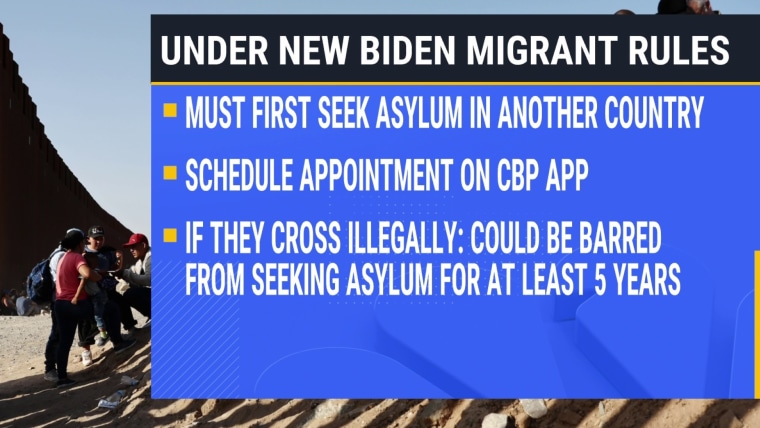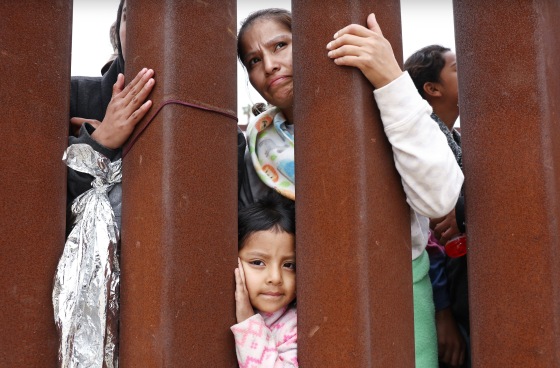Former President Donald Trump predicted last week that May 11, the day that the Title 42 pandemic restriction ended at the U.S.-Mexico border, would be “a day of infamy” with “millions” of migrants arriving. Former Vice President Mike Pence, referring to the public health emergency order that allowed the U.S. to expel migrants more quickly without having to consider their asylum requests, tweeted, “A storm is coming with the end of Title 42.” Neither prediction sounded right to those of us at the Washington Office on Latin America who actually visit the migration route and talk to people coming to the United States.
My organization predicted before Title 42 ended that any post-May 11 increase in migrant arrivals would “be neither giant nor long-lasting.”
In fact, my organization predicted before Title 42 ended that any post-May 11 increase in migrant arrivals would “be neither giant nor long-lasting.” And, true to that prediction, at least in the first days after Title 42’s lifting, there was no increase at all. To the contrary: A top Homeland Security official told reporters on Monday that compared to the days before May 11, “we have seen a substantial decrease in unlawful crossings at the border and irregular migration, averaging less than half that many encounters.” We are hearing similar reports from colleagues who work with migrants at the border.
Though a short-term drop in migration was foreseeable, a 50% reduction is remarkably steep. Those reduced numbers, though, probably won’t last long: All the forces that cause so many people to migrate are still in place.
Essentially, migrants — and the network of smugglers along the route between countries of origin and the United States — are in “wait and see” mode. They are uncertain about what President Joe Biden’s administration’s tough-sounding new policies will mean for them. A new rule, called the “transit ban,” is making it much harder for people to apply for asylum simply by turning themselves in to U.S. agents. (This new rule is already being challenged in court on the grounds that it is illegal.)
The new border rules are strict and complicated. How much harder it will be to apply for asylum and what happens to people after they’re rejected remain very unclear. It’s not surprising that migrants who’ve reached Mexico are pausing before taking a leap into the unknown.

We’ve seen such “wait and see” moments before. In 2014, after a mass arrival of Central American children and families surprised the Obama administration, the U.S. and Mexico declared a crackdown, and migration dropped — only to increase again throughout 2015 and 2016. After Trump’s inauguration in January 2017, migration plummeted to levels not seen since the Nixon administration. That drop happened so quickly that it was as if someone had thrown a switch. But then the number of migrants climbed so rapidly that, by 2018, an enraged Trump was deploying troops and separating families at the border. A version of “wait and see” also occurred in March 2020 after government officials concerned about Covid tightened borders everywhere, and the Title 42 policy went into effect. Again, migration increased within months.
Every “wait and see” period has reduced migrant flows. Then, within weeks or months, that higher flow of migrants resumes. Title 42’s replacement with a harsh new rule should be no exception.
People will keep coming in large part because the entire Western Hemisphere is experiencing a historic moment of migration.
Daily migration totals are likely to be higher by Memorial Day, and then increase throughout the summer. But because Biden’s new rules are easing neither migration nor asylum access, migration totals are unlikely to exceed the levels that we’ve already seen during this administration. U.S. border authorities have encountered an average of 194,000 migrants per month since Inauguration Day 2021.
People will keep coming in large part because the entire Western Hemisphere is experiencing a historic moment of migration. A whole quarter of Venezuela’s 30 million population has fled to neighboring countries since the mid-2010s amid political repression and economic collapse, while Haitians, Nicaraguans and other nationalities continue to seek refuge throughout the Americas. The opening of Panama’s once-impassible Darién Gap has enabled overland migration from South America. And a perfect storm of violence, economic conditions exacerbated by Covid, climate change and political repression portend continued mass flight.

And the migration is not just originating in the Western Hemisphere: All year, officials at the U.S.-Mexico border have seen more than 1,000 migrants per month from China, Russia, India and Turkey. On a visit to the Honduras-Nicaragua border at the end of April, WOLA staff found hundreds of migrants lining up for identity documents. My colleagues and I spoke to people from Venezuela and Haiti, but also from China, Pakistan, Tajikistan and elsewhere. A bus company operator told me that they are running 25 full buses per day on a direct route across the country, to the border with Guatemala and then onward.
The “wait and see” mode intensifies in Mexico. Smugglers, and migrants themselves, are trying to understand what approaches “work” and which do not under the new rules.
Attempts to deter migrants at the border are cruel: They deny protection, they force determined migrants to risk their lives in harsh deserts, they shove people into dangerous Mexican border cities.
Attempts to deter migrants at the border, like the new “transit ban” rule, are cruel: They deny protection, they force determined migrants to risk their lives in harsh deserts, they shove people into dangerous Mexican border cities. Such policies, recalling Trump’s words, are the true “infamy.” And as past “wait and see” moments have shown, harsh new policies just won’t keep migration as low as what we’ve seen over the last few days. The numbers will recover, though they probably won’t break new records.
The forces driving people to leave their homes are too strong to dissuade people from attempting the journey. No amount of deterrence can, or ever should, impose more suffering than can gangs in Haiti, pro-government thugs in Nicaragua, or hunger in Venezuela. The Biden administration’s approach to migration will neither be effective nor humane if it doesn’t align with that reality.
